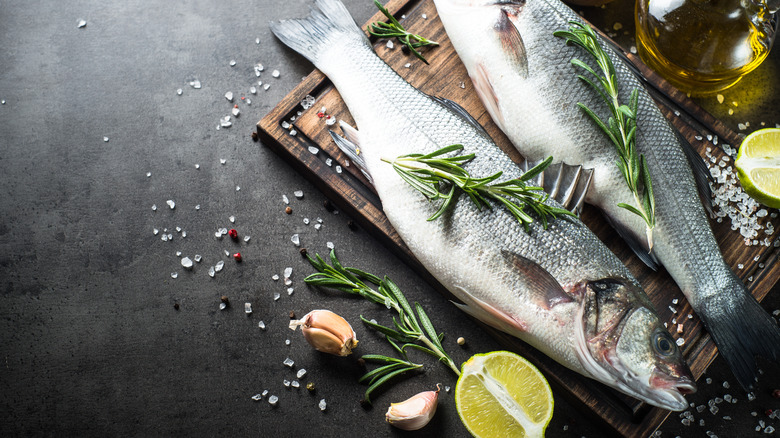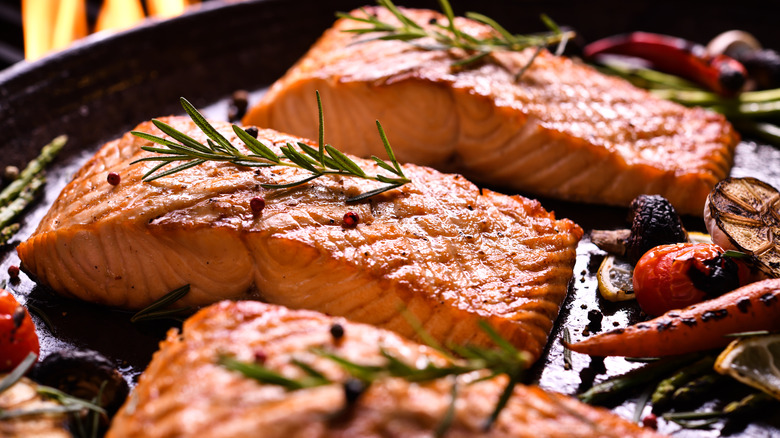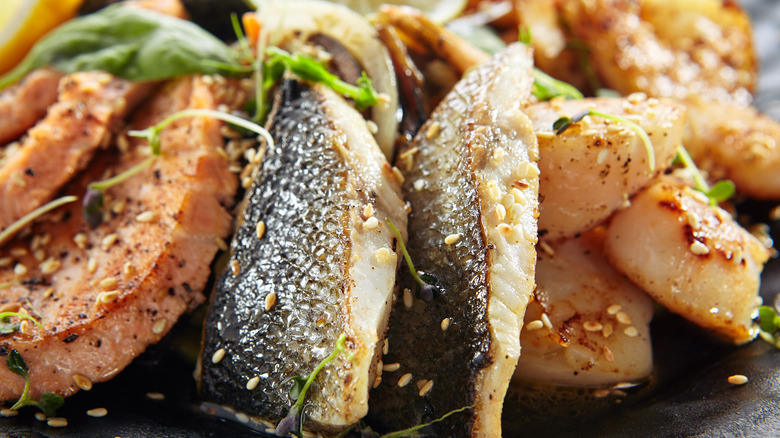Why It's A Good Idea To Grill Fish With The Skin On
Skin on or skin off? Asking that question when it comes to grilling or eating fish can elicit some strong opinions. Regardless of where you land on the culinary fish skin debate, there are lots of reasons for leaving it on, both during the cooking process and after the fish reaches your dinner plate. Some preferences come down to personal taste or predispositions, while others rely on the nutritional attributes of fish skin.
There's no question that fish overall is considered a heart-healthy food that's chockfull of vitamins and antioxidants, according to WebMD. The omega-3 fatty acids in fish can help maintain brain health during aging, lower the risk of heart disease, thwart depression, aid in thyroid function, and provide protein for healthy muscles and organs. But how many of these benefits come from leaving the skin on your fish? That can depend on the type of fish you choose.
Fish skins have notable benefits
Though most fish are tasty, they're not all created equal when it comes to benefits for humans. Generally, the good-for-you fatty oils you get from eating the flesh of a fish are also present in the skin. Healthline recommends eating low-mercury fish such as salmon, tilapia, flounder, and cod, noting that mercury levels can be present in the skin as well as in the flesh. In an Epicurious interview with Mark Usewicz, chef and co-owner of Mermaid's Garden sustainable seafood market, he expresses a similar preference for eating extra-crispy fish skin from species such as flounder and salmon, plus sea bass, snapper, and mackerel.
In addition to the well-known health benefits of eating fish in general, consuming fish skin also can help maintain healthy human skin, per Healthline. It contains vitamin E, which can protect your skin from sunburn and may help improve eczema. The collagen in fish skin could facilitate hydration, elasticity, and potential wrinkle resistance. Since fish flesh on its own is typically low in collagen, leaving the collagen-rich fish skin on while cooking can coat and lubricate the entire fish with healthy collagen.
A boost to taste and texture
Especially when it's pan-fried or grilled, crispy fish skin can be delicious, and leaving the skin on can make for a better cooking experience. According to Bon Appétit, cooking fish with the skin side down in the pan, on either the stovetop or grill, protects the flesh from getting burned or dried out, and it helps to make flipping easier without reducing your perfect catch into a crumbled mess. Cook it skin-down until about 90% done before flipping.
For the best crispy texture, make sure the fish skin is dry before cooking, explains Serious Eats. You can accomplish this by lightly scraping a knife across the surface several times, similar to how a windshield wiper skims glass, and then patting the skin with paper towels. Avoid using nonstick pans if you want the ultimate crisp factor. Instead, reach for your seasoned cast iron or carbon steel pans whenever possible.
It's a pretty universal consensus that eating fish skin is safe, healthy, and delicious when crispy. So, dive right in and let nature's aquatic wonders do what they're meant to do.


